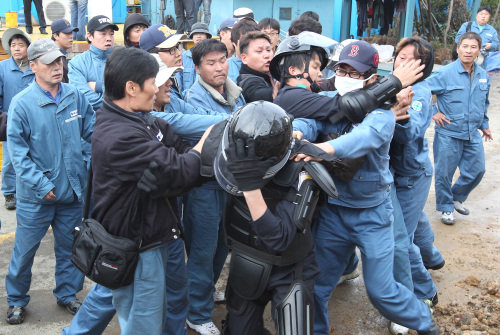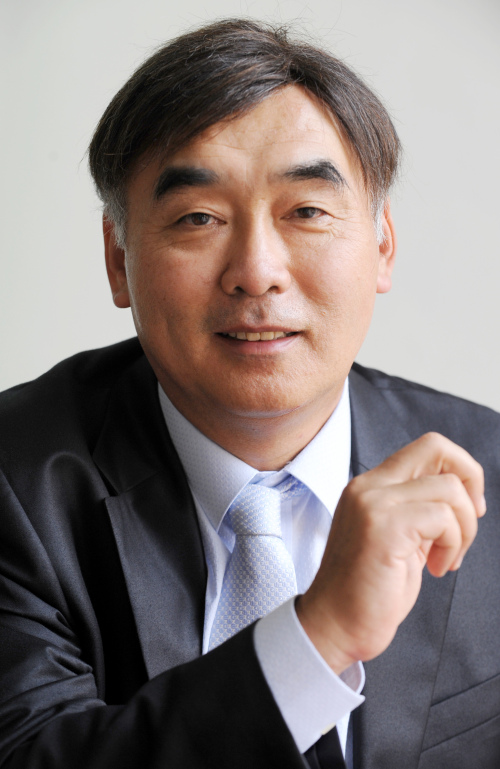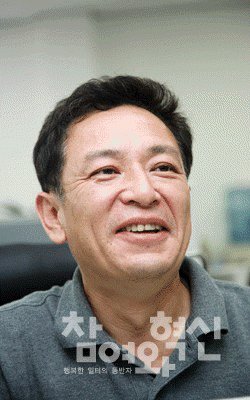With the Hanjin dispute finally resolved ...
Are Korea’s trade unions too powerful?
The influence of organized labor
By most measures, Korean trade unionism is at its lowest ebb in two decades. The union participation rate today of 9.8 percent is less than half of what it was in 1989. Among OECD countries, Korean workers’ unionization ranks near bottom.
That does not mean that unions do not still wield considerable power. The recently ended labor dispute at Hanjin Heavy Industries & Construction is a case in point: After an 11-month stand-off, the company’s union eventually secured reinstatement for some laid-off workers and severance packages of 20 million won each for others. But whether unions’ influence is a net positive is a subject of debate.
Critics accuse union leaders of serving their own interests before those of their workers and undue participation in politics, and say the current setup harms Korea’s business competitiveness. To others, the unions are a necessary counterweight to the power of chaebol and to thank for gains in workers’ rights and working conditions ― making the idea of curbing their power ridiculous if not sinister.
Are Korea’s trade unions too powerful?
The influence of organized labor
By most measures, Korean trade unionism is at its lowest ebb in two decades. The union participation rate today of 9.8 percent is less than half of what it was in 1989. Among OECD countries, Korean workers’ unionization ranks near bottom.
That does not mean that unions do not still wield considerable power. The recently ended labor dispute at Hanjin Heavy Industries & Construction is a case in point: After an 11-month stand-off, the company’s union eventually secured reinstatement for some laid-off workers and severance packages of 20 million won each for others. But whether unions’ influence is a net positive is a subject of debate.
Critics accuse union leaders of serving their own interests before those of their workers and undue participation in politics, and say the current setup harms Korea’s business competitiveness. To others, the unions are a necessary counterweight to the power of chaebol and to thank for gains in workers’ rights and working conditions ― making the idea of curbing their power ridiculous if not sinister.

Yes:Militancy is hurting competitiveness
There are about 1.6 million union members ― 9.8 percent of the total employed ― who belong to nearly 4,700 local unions. Korea’s union participation rate is very low compared to other OECD countries. For example, even in the U.S. which has one of the lowest union participation rates among OECD countries with France, 13 percent of the workforce are union members.
However, Korean unions are very powerful. Korean union membership is predominately of male workers in key sectors. The unions of large enterprises in chaebol are as influential as the power of large enterprises in the Korean economy. Unions are organized in most big enterprises except companies belonging to Samsung and POSCO whose human resource management policies are also, to some extent, influenced by union movement.
An important development in Korean unionism after 1987 was the emergence and rise of a movement independent of the officially recognized Federation of Korea Trade Unions. There were many attempts to organize a separate national center by union activists who did not follow FKTU policy lines although Korean law allowed only one national center until 1997. Non-recognized unions formed the Korea Confederation of Trade Unions and the KCTU was officially recognized by the government in 1999.
The leaders of the new union movement have been critical of the FKTU, which had close ties with government and employers under the authoritarian regimes of Presidents Park Chung-hee and Chun Doo-hwan. The KCTU claims a membership of 588,000, while the FKTU has 730,000 members. Although the KCTU membership is less than that of the FKTU, the KCTU is as powerful as the FKTU since its enterprise affiliates include those of the large chaebol in key sectors of the Korean economy. KCTU-affiliated unions are based in the large manufacturing firms that were unionized after 1987.
Now, the KCTU should be criticized for its militant policies. About 90 percent of Korea’s labor disputes take place at KCTU-affiliated unions’ workplaces. The KCTU seems to have a policy of no-compromise. Its unions often make demands hardly acceptable to their employers. The KCTU’s stubborn policy is well shown in the prolonged labor dispute at Hanjin Heavy Industries & Construction. Hanjin Heavy laid off more than 400 workers at a shipyard in the southern port city of Busan last December. The shipbuilder and its union reached an agreement to go back to work in late June and a court ruled the collective dismissal of Hanjin Heavy justified. But dozens of others including the KCTU continued their protest at the shipyard which only ended recently.
The FKTU which is still the majority national union center has not fully reshaped from its past legacy of non-independent unionism. About 20 percent of Korea’s local unions do not belong to either the FKTU or the KCTU. Moreover, 74.5 percent of 324 newly-organized unions ― as union pluralism has been allowed at workplaces since last July ― are those separate from the two umbrella organizations.
According to the report by the World Economic Forum, Korea’s competitiveness index dropped to 24th place out of 142 countries surveyed this year. The labor market was ranked 76th. Militant unions and poor labor and management cooperation are blamed for Korea’s weak labor market competitiveness. Foreign capitalists are often reluctant to invest in Korea due to Korea’s militant unions.
Unions’ role can be positive for society by representing workers’ interests suffering from employers’ own discretion. However, Korean unions mostly represent interests of regular workers in large enterprises. In late August the labor union at Hyundai Motor Co. agreed with the management on a wage deal for 2011 which increased the average annual wages of its members to 90 million Korean won ($75,000). Less than 50 percent of new college graduates find a job within six months of their graduation. A typical worker’s wages are less than 60 percent of wages of regular workers. Korean unions and union members should sacrifice their own interests for the less-privileged workers in the labor market.

By Park Young-bum
Park Young-bum is a professor of economics at Hansung University in Seoul. ― Ed.
No: Unions need more clout, not less
No, Korea’s labor unions do not have “too much” power. On the contrary, they need to gain more clout to represent more workers and better protect their rights and interests.
Government data released earlier this month put Korea’s unionization rate last year at 9.8 percent. This means that union membership declined to single digits for the first time and fell by half from a near-20 percent peak in 1989.
There are some errors in the Labor Ministry figures, though. For instance, it did not count about 100,000 members of the Korea Government Employees’ Union, after it refused to recognize the KGEU as a legitimate union, citing some procedural reasons. Another 100,000 are also left out because the government does not recognize unionized self-employed drivers of cargo, dump and Remicon (ready-mixed cement) trucks as workers.
Another key factor that contributed to the decline in union membership is high jobless rates among workers in their 20s and 30s, while those in their 50s and 60s continue to stay in jobs.
Whatever the reasons may be, the union organization rate is one of the lowest in the Organization for Economic Cooperation and Development. Only two countries ― France and Turkey ― have figures lower than Korea.
With France, while its union membership is low, collective bargaining coverage is very high (above 90 percent), which means that workers are covered by collective bargaining agreements, even if they do not join trade unions. Here in Korea, union coverage is low and collective bargaining covers only union members. Given all this, the claim that Korean labor unions have too much power is unfounded.
In fact, the labor movement has weakened under the administration of Lee Myung-bak who rolled out a series of pro-business ― or more precisely pro-chaebol ― and anti-labor polices.
The three basic rights of workers ― to organize, bargain collectively and strike ― guaranteed by Article 33 of the Constitution, have become virtually useless. Workers with non-standard forms of employment, such as the Korea Cargo Transport Workers’ Union’s self-employed truck drivers, are denied their right to organize.
Employees of state-owned companies face limits in the right to collective bargaining. All strikes are considered illegal in this country if workers do not go through a quasi-judicial panel and win its ruling that a strike would be legitimate. On top of all this, management uses damages suits as a tactic to undermine trade unions.
Korea may have had “powerful” unions back in the ‘80s and ‘90s. At that time, unions of large conglomerates fiercely fought for job security, because losing jobs meant a social death sentence in a country with a weak social safety net.
But going through two economic crises ― the Asian financial crisis in late ‘90s and the U.S. subprime mortgage crisis in 2008 ― the country’s labor force has become sharply polarized between regular workers at large corporations and workers at smaller firms and non-regular workers. This polarization led to a significant drop in labor strife involving unions of major conglomerates that represent better-off workers.
The Korea Confederation of Trade Unions as a national trade union center has been striving to bridge the widening gap between regular and non-regular workers and tackle discrimination against non-regulars, but such efforts are falling short of slowing the bipolarization of the workforce.
The labor movement in newly industrialized countries is distinctively different from that of the West, which has a centuries-long history.
In the West, trade unions and social democratic parties were the two drivers of the labor movement. But here in Korea, trade unions, with a short history and no political party to represent them, had to struggle to earn their way.
Korea’s labor movement has been changing, however, since 2000 when the Democratic Labor Party entered the National Assembly. Trade unions are now building a complementary relationship with the DLP and other progressive parties.
Labor unrest in the 2000s has been centered on two key issues ― massive layoffs and the subsequent increase of marginalized workers in non-regular forms of employment. A Korea Cargo Transport Workers Union’s strike in 2003, remembered for its paralyzing impact on almost all industries, also originated from this trend: Truck drivers joined trade unions in droves after they were kicked out of permanent jobs into self-employment status.
In January this year, the public sympathized with irregular cleaning staff at Hongik University in Seoul who staged a sit-in to protest layoffs and poor working conditions.
Aged over 60, the workers were employed through a cleaning agency and received around 750,000 won a month and a daily meal allowance of 300 won. The 309-day labor struggle at Hanjin Heavy Industries & Construction Co. also revealed how easily management wields the layoff ax.
The Korean government is going all-out to get the Korea-U.S. Free Trade Agreement ratified by the parliament. The eagerness and enthusiasm for the trade pact contrasts with its silence on conventions of the International Labor Organizations, which set standards for labor rights. From workers’ point of view, Korea is a backward country, having ratified only 24 of the ILO’s 187 conventions.
In conclusion, I dare to say that Korea’s labor unions do not have enough power. They need to gain more clout to enhance workers’ rights against the anti-trade union policies of the current administration.
Park Young-bum is a professor of economics at Hansung University in Seoul. ― Ed.
No: Unions need more clout, not less
No, Korea’s labor unions do not have “too much” power. On the contrary, they need to gain more clout to represent more workers and better protect their rights and interests.
Government data released earlier this month put Korea’s unionization rate last year at 9.8 percent. This means that union membership declined to single digits for the first time and fell by half from a near-20 percent peak in 1989.
There are some errors in the Labor Ministry figures, though. For instance, it did not count about 100,000 members of the Korea Government Employees’ Union, after it refused to recognize the KGEU as a legitimate union, citing some procedural reasons. Another 100,000 are also left out because the government does not recognize unionized self-employed drivers of cargo, dump and Remicon (ready-mixed cement) trucks as workers.
Another key factor that contributed to the decline in union membership is high jobless rates among workers in their 20s and 30s, while those in their 50s and 60s continue to stay in jobs.
Whatever the reasons may be, the union organization rate is one of the lowest in the Organization for Economic Cooperation and Development. Only two countries ― France and Turkey ― have figures lower than Korea.
With France, while its union membership is low, collective bargaining coverage is very high (above 90 percent), which means that workers are covered by collective bargaining agreements, even if they do not join trade unions. Here in Korea, union coverage is low and collective bargaining covers only union members. Given all this, the claim that Korean labor unions have too much power is unfounded.
In fact, the labor movement has weakened under the administration of Lee Myung-bak who rolled out a series of pro-business ― or more precisely pro-chaebol ― and anti-labor polices.
The three basic rights of workers ― to organize, bargain collectively and strike ― guaranteed by Article 33 of the Constitution, have become virtually useless. Workers with non-standard forms of employment, such as the Korea Cargo Transport Workers’ Union’s self-employed truck drivers, are denied their right to organize.
Employees of state-owned companies face limits in the right to collective bargaining. All strikes are considered illegal in this country if workers do not go through a quasi-judicial panel and win its ruling that a strike would be legitimate. On top of all this, management uses damages suits as a tactic to undermine trade unions.
Korea may have had “powerful” unions back in the ‘80s and ‘90s. At that time, unions of large conglomerates fiercely fought for job security, because losing jobs meant a social death sentence in a country with a weak social safety net.
But going through two economic crises ― the Asian financial crisis in late ‘90s and the U.S. subprime mortgage crisis in 2008 ― the country’s labor force has become sharply polarized between regular workers at large corporations and workers at smaller firms and non-regular workers. This polarization led to a significant drop in labor strife involving unions of major conglomerates that represent better-off workers.
The Korea Confederation of Trade Unions as a national trade union center has been striving to bridge the widening gap between regular and non-regular workers and tackle discrimination against non-regulars, but such efforts are falling short of slowing the bipolarization of the workforce.
The labor movement in newly industrialized countries is distinctively different from that of the West, which has a centuries-long history.
In the West, trade unions and social democratic parties were the two drivers of the labor movement. But here in Korea, trade unions, with a short history and no political party to represent them, had to struggle to earn their way.
Korea’s labor movement has been changing, however, since 2000 when the Democratic Labor Party entered the National Assembly. Trade unions are now building a complementary relationship with the DLP and other progressive parties.
Labor unrest in the 2000s has been centered on two key issues ― massive layoffs and the subsequent increase of marginalized workers in non-regular forms of employment. A Korea Cargo Transport Workers Union’s strike in 2003, remembered for its paralyzing impact on almost all industries, also originated from this trend: Truck drivers joined trade unions in droves after they were kicked out of permanent jobs into self-employment status.
In January this year, the public sympathized with irregular cleaning staff at Hongik University in Seoul who staged a sit-in to protest layoffs and poor working conditions.
Aged over 60, the workers were employed through a cleaning agency and received around 750,000 won a month and a daily meal allowance of 300 won. The 309-day labor struggle at Hanjin Heavy Industries & Construction Co. also revealed how easily management wields the layoff ax.
The Korean government is going all-out to get the Korea-U.S. Free Trade Agreement ratified by the parliament. The eagerness and enthusiasm for the trade pact contrasts with its silence on conventions of the International Labor Organizations, which set standards for labor rights. From workers’ point of view, Korea is a backward country, having ratified only 24 of the ILO’s 187 conventions.
In conclusion, I dare to say that Korea’s labor unions do not have enough power. They need to gain more clout to enhance workers’ rights against the anti-trade union policies of the current administration.

By Jeong Ho-hee
Jeong Ho-hee is spokesperson of the Korean Confederation of Trade Unions, the country’s second-largest umbrella labor group with more than 580,000 workers. ― Ed.
-
Articles by Korea Herald







![[Graphic News] More Koreans say they plan long-distance trips this year](http://res.heraldm.com/phpwas/restmb_idxmake.php?idx=644&simg=/content/image/2024/04/17/20240417050828_0.gif&u=)
![[KH Explains] Hyundai's full hybrid edge to pay off amid slow transition to pure EVs](http://res.heraldm.com/phpwas/restmb_idxmake.php?idx=644&simg=/content/image/2024/04/18/20240418050645_0.jpg&u=20240419100350)






![[From the Scene] Monks, Buddhists hail return of remains of Buddhas](http://res.heraldm.com/phpwas/restmb_idxmake.php?idx=652&simg=/content/image/2024/04/19/20240419050617_0.jpg&u=20240419175937)

![[KH Explains] Hyundai's full hybrid edge to pay off amid slow transition to pure EVs](http://res.heraldm.com/phpwas/restmb_idxmake.php?idx=652&simg=/content/image/2024/04/18/20240418050645_0.jpg&u=20240419100350)

![[Today’s K-pop] Illit drops debut single remix](http://res.heraldm.com/phpwas/restmb_idxmake.php?idx=642&simg=/content/image/2024/04/19/20240419050612_0.jpg&u=)